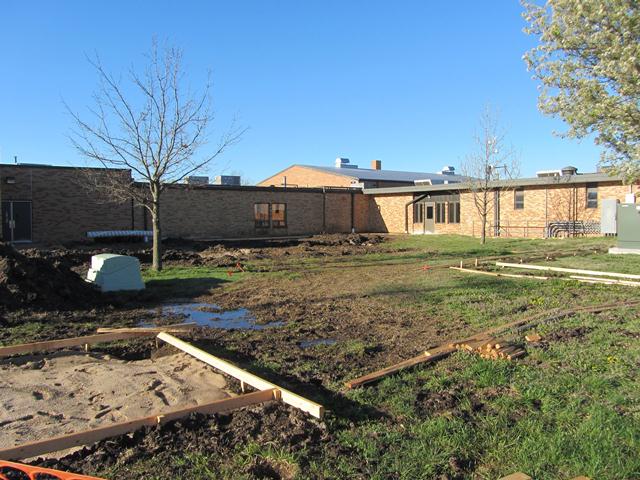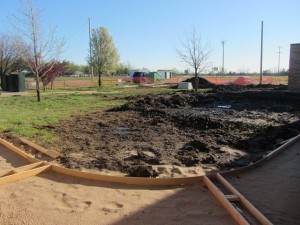 After a week of rain, progress on Benton’s Backyard outdoor classroom and learning garden can be seen. Sunburnt and covered in dirt, a few hard working dads framed up the sidewalks, shed floor, pergola floor and mow strips in preparation for concrete to be poured. Our students returned from spring break to witness all of the changes.
After a week of rain, progress on Benton’s Backyard outdoor classroom and learning garden can be seen. Sunburnt and covered in dirt, a few hard working dads framed up the sidewalks, shed floor, pergola floor and mow strips in preparation for concrete to be poured. Our students returned from spring break to witness all of the changes.
Progress on this type of project does not happen unless you have a network of dedicated staff members and volunteers. When we originally set out on this journey, we began talking about long-term sustainability. Repeatedly, we have heard stories of neglected school that become dismantled because of staff changes, building additions and financial constraints. We do not want this to happen to our plod of earth! Long-term sustainability is a conversation we continually have.
An early goal, set by our committee, was to build this classroom right the first time. We addressed these three potential deal breakers.
Staff Changes: In gardening, we know that soil is the main ingredient. A garden containing only clay is not going to produce a crop. Soil made up of sand, silt and clay is the best combination for growing a healthy productive garden. That’s what we needed at Benton, a combination of teachers, staff, and parents; all with different talents and interest in Benton’s Backyard. If one person moves out of district, there remains a team of invested committee members carrying the mission of Benton’s Backyard forward.
 Building Additions and Construction: Years ago, our school had an outdoor wildlife learning site. Gradually, our enrollment increased and we had to construct additional classrooms to accommodate students. The outdoor wildlife-learning site, built with grant money and hours of teacher, student, and volunteer time, was dismantled and the district built a bigger school. It was heartbreaking and such a waste. At school garden conferences, I have heard from numerous school gardeners who share the same sad tale. To prevent this from happening again we set out to make Benton’s Backyard a permanent addition to the school, where a trip to the backyard is a daily classroom experience and not an extra-curricular activity for our students.
Building Additions and Construction: Years ago, our school had an outdoor wildlife learning site. Gradually, our enrollment increased and we had to construct additional classrooms to accommodate students. The outdoor wildlife-learning site, built with grant money and hours of teacher, student, and volunteer time, was dismantled and the district built a bigger school. It was heartbreaking and such a waste. At school garden conferences, I have heard from numerous school gardeners who share the same sad tale. To prevent this from happening again we set out to make Benton’s Backyard a permanent addition to the school, where a trip to the backyard is a daily classroom experience and not an extra-curricular activity for our students.
We spent extra time and money planning an elaborate outdoor classroom and learning garden that goes beyond a couple of raised beds and a bird bath (nothing against a couple of raised beds and bird bath, we just wanted more). Furthermore, we wanted a structure one would see as permanent and not temporary. We identified four possible locations for an outdoor classroom and brought district personnel, including the school superintendent and the ground maintenance superintendent into the conversation. The two questions we asked, “If you were to build an addition on to the school, where would you put it?” and “Do you foresee any changes in the school that would disturb or affect this spot?”
It was also critical for us to determine if there was enough light to have a garden (6-8 hours), where the water and electricity would come from and other obstacles that might have caused a problem (I am referring to two very large electrical boxes that could NOT be moved). After multiple meetings, we were able to move forward with confidence knowing we had chosen the best location for now and for the future.
Financial Constraints: “If money grew on hackberry trees, that would be all right,” with Alan Jackson and me. A Nutrients for Life learning garden survey revealed that the number one obstacle facing the installation and success of school learning gardens is money.
As we are all aware, school budgets are tight. Simply stated, we were not going to get money from the school. You have to look for money elsewhere. We created our budget and set a financial goal. We needed to raise $44,000 (I know, that’s crazy!). Well, we were optimistically confident (and maybe a little naive on how much work it would take)!
For capital, we decided the best way to raise money was by writing grants. We scoured the web for community, state, and national grants related to wildlife habitat, school gardens, school nutrition, childhood diabetes, recycling, agriculture awareness, environmental awareness, fruit trees, rural development, etc. We shared our vision with as many people as possible and followed every lead and open door presented to us. This was by far the hardest part of the entire process. We had to be persistent and not let the no-s and rejections get us down. In our case, most of the grants were written by parent volunteers with support and input from teachers (consider yourself lucky if you have someone on staff who is paid to write grants). We wrote grant, after grant, after grant. Whether it was $100 or $10,000, we were grateful and celebrated every grant we were awarded!
A spring plant sale was added to our fundraising efforts. The plant sale was a huge success and we now plan to offer the plant sale as an annual event. Monies raised will provide for long-term sustainability of Benton’s Backyard, as we will be able to make repairs, improvements, purchase additional supplies, provide teacher training, and new curriculum.
To this point, we have avoided any deal breakers and continually plan and make decisions based on long-term sustainability. I have to give credit to our committee that is not afraid to roll up their sleeves, put on our garden gloves and dig in with dedication, persistence, creativity, and teamwork.
Read more about classroom gardens in our Learning Garden blog series:
Learning Garden 2: Long-Term Sustainability
Learning Garden 4: Designing the Garden
Learning Garden 7: Raised Beds
Learning Garden 8: Plant Selection
Learning Garden 9: Rain Barrels
Learning Garden 10: How Does Your Garden Grow?
Learning Garden 11: Planting Day
Learning Garden 12: Teach the Teacher
Learning Garden 13: First Harvest
Learning Garden 14: How Do You Say Thank You
Learning Garden 15: Plant a Seed and Watch It Grow
Learning Garden 16: From the Learning Garden to the Cafeteria





What is the best way to manage weeds and watering through the summer while school is out
Jer, A few suggestions: 1. Create watering/weeding schedule and have volunteers maintain during the summer. 2. Leave the garden fallow (empty) for the summer months. 3. Install and maintain an irrigation system that is overseen by some volunteers during the summer months. 4. Allow families to adopt the garden for the summer.
Hope this help! Good Luck! Dee